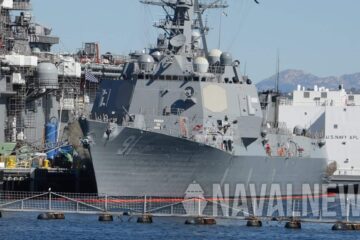U.S. Navy press release
Due to public health and safety restrictions on large public events resulting from the novel coronavirus (COVID-19) pandemic, the ceremony was a private event celebrated alongside ship plankowners and former crew members.
During the ceremony, keynote speaker, Vice Adm. Roy Kitchener, Commander, Naval Surface Force, U.S. Pacific Fleet, wished the crew of Independence fair winds and following seas as they said farewell to their ship.
“The Independence crew shouldered a heavy responsibility. Since the ship’s introduction into the fleet we asked her to serve for a specific purpose; to test emerging equipment and concepts.”
“The crew accomplished that and so much more. Without their efforts and experiences, the ship class would not be where it is today with six ships deployed throughout the world. Those improvements, made largely in part due to this crew’s experience and input, will continue to carry the LCS class into the future.”
Vice Adm. Roy Kitchener, Commander, Naval Surface Force, U.S. Pacific Fleet
The commissioning Commanding Officer of USS Independence gold crew, Capt. Michael Riley said it was the Sailors who rose to the occasion that made Independence prosperous.
“What made Independence successful wasn’t the program managers, industry professionals or even her two captains. It was the officers, chiefs and Sailors of the blue and gold crews that made it operational. They shouldered the burden of shifting programmatic guidance, incomplete documentation or one-of-a-kind systems, and got it to sea.”
“They were honest in pointing out when system performances or operational processes failed to live up to their expectations. At the same time, they discovered hidden capabilities in the ship, repurposing equipment and systems to suit the situation.”
Commanding Officer of USS Independence gold crew, Capt. Michael Riley
Independence maintained a crew of nine officers and 41 enlisted Sailors. The ship was built in Mobile, Alabama by Austal USA and commissioned Jan. 16, 2010.

Independence is the sixth ship to carry the name, recognizing the cornerstone of our nation’s foundation for which so many Americans have fought and died. The first Independence was a 10-gun sloop that served during the American Revolution. The second Independence, the first ship of the line in the Navy, was launched in 1814 as a 74-gun ship, but later refitted to a 54-gun frigate. The third Independence served with the Naval Overseas Transportation Service (NOTS) following the end of World War I. The fourth Independence (CVL 22), a small aircraft carrier commissioned in 1943, earned eight battle stars during World War II. The fifth Independence (CV 62) was an aircraft carrier commissioned in 1959 and decommissioned in 1998.
Independence has been a test and training ship and was key in developing the operational concepts foundational to the current configuration and deployment of LCS today. The decommissioning of LCS 2 supports department-wide business process reform initiatives to free up time, resources, and manpower in support of increased lethality. The LCS remains a fast, agile, and networked surface combatant, designed to operate in near-shore environments, while capable of open-ocean tasking and winning against 21st-century coastal threats.
The LCS class consists of two variants, the Freedom variant and the Independence variant, designed and built by two industry teams. The Freedom variant team is led by Lockheed Martin and is a steel monohull design constructed in the Fincantieri Marinette Marine Corporation’s shipyard in Marinette, Wisconsin. The Independence variant is an aluminum trimaran design originally built by an industry team led by General Dynamics Bath Iron Works for LCS 2 and LCS 4. Currently, Independence variant LCS are constructed by Austal USA in the company’s Mobile, Alabama shipyard.
LCS are outfitted with mission packages (made up of mission systems and support equipment) that deploy manned and unmanned vehicles and sensors in support of mine countermeasures, anti-submarine warfare or surface warfare missions.
After the decommissioning of Independence, 22 littoral combat ships remain in service to the fleet.
–End-






